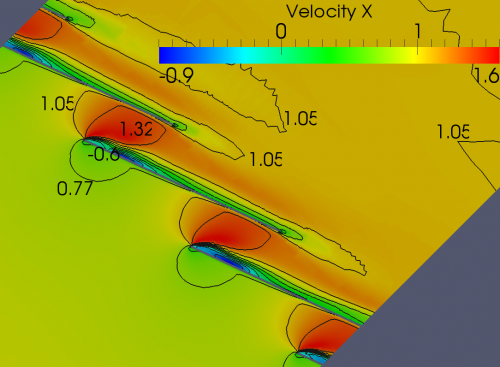Study determines best arrangement of tidal sails device

In the long sprint to find new sources of clean, low-cost power, slow and steady might win the race—the slow-moving water of currents and tides, that is. Just as wind turbines tap into the energy of flowing air to generate electricity, hydrokinetic devices produce power from moving masses of water.
In a paper appearing in AIP Publishing's Journal of Renewable and Sustainable Energy, Ramon Fernandez-Feria, a professor of fluid mechanics at Universidad de Málaga in Spain, and his colleagues Joaquin Ortega-Casanova and Daniel Cebrián performed a computer simulation to determine the optimum configuration of one such system to enable it to extract the maximum amount of energy from any given current.
The system, developed by a Norwegian company called Tidal Sails AS, consists of a string of submerged blades or sails, connected via wire ropes, angled into the oncoming current. The rushing current generates large lift forces in the sails, and as they are pushed along through a continuous loop, they drive a generator to produce electricity.
A small-scale version of the Tidal Sails device is already in operation at a test facility constructed in a stream outside Haugesund, Norway. The pilot project has a power-producing capacity of 28 kilowatts; a full-scale version could generate several megawatts of power. Installing several such units in a tidal stream, the company says, could generate as much as 100 gigawatts of electricity per year.
In their analysis, the researchers found that the maximum amount of power could be generated using blades with a chord length (the width of the blade at a given distance along its length) equal to the separation between each individual blade, that are positioned at about a 79 degree angle relative to the oncoming current, and that move at a speed about one and half times faster than the current.
"The next step would be to refine the design of the device with further hydrodynamic numerical simulations, complemented with small-scale experiments," Fernandez-Feria said. "For instance, trying more efficient aerodynamic blade profiles, and different angles between the string of blades and the current."
More information: The article, "Lift and drag characteristics of a cascade of flat plates in a configuration of interest for a tidal current energy converter: Numerical simulations analysis" by Daniel Cebrián, Joaquin Ortega-Casanova and Ramon Fernandez-Feria appears in the Journal of Renewable and Sustainable Energy: dx.doi.org/10.1063/1.4816495
Journal information: Journal of Renewable and Sustainable Energy
Provided by American Institute of Physics



















